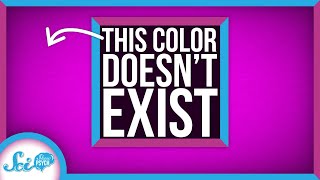(单词翻译:单击)
The world is full of colors.
这个世界充满色彩。
Some vibrant, some dull, and some… that are all in our heads.
有的色彩充满活力,有的沉闷,还有一些别的,它们都在我们的脑海里。
In fact, you're looking at a color on-screen right now that, in a sense, doesn't even exist.
事实上,从某种意义上说,你现在在屏幕上看到的色彩,根本不存在。
Unlike virtually all other colors, there's no wavelength of light to describe it, but we see it anyway.
与几乎所有其他颜色不同的是,没有光的波长来描述它,但我们还是看到了它。
It's magenta.
它就是洋红色。
And it's nothing but a trick from your brain.
这不过是大脑玩的一个小把戏。
Our eyes can see things because in the back of the eye, there are millions of receptors called rods and cones.
我们眼睛能看到东西,因为在眼睛的后部,有数百万个称为视杆和视锥的受体。
Rods are sensitive to light intensity and movement, while cones are the receptors that see color and fine detail.
视杆细胞对光的强度和运动很敏感,而视锥细胞则是感知颜色和细节的受体。
There are all kinds of cones out there in the animal kingdom, but humans have three types of them:
在动物王国里有各种各样的锥体,但人类有三种类型:
one that detects long wavelengths like red light, one that detects medium wavelengths like green light, and one for short wavelengths like blue light.
一种探测红光等长波,一种探测绿光等中等波长的光,还有一种探测蓝光等短波长的光。
When light enters the eye, it causes some of these cones to fire depending on what wavelength it is.
当光线进入眼睛时,它会根据波长不同引起一些锥体细胞启动。
So, if you're looking at a red apple, your long wavelength cones might fire.
所以,如果你看到一个红苹果,长波锥体可能会启动。
Or if you're looking at the sky, your short wavelength — or blue cones — might.
或者,如果你看天空时,短波或者蓝色锥体可能会启动。
But as you might have learned, or noticed, there are more than three colors in the world.
但是正如你所了解到的,或是注意到的,世界上有三种以上的颜色。
So, how do we get by with only three types of cones?
那么,我们只有三种锥状体该怎么应对呢?
Well, our eyes kind of cheat.
我们的眼睛会欺骗。
Because while each type of cone is most sensitive to a specific color, they actually respond to a range of wavelengths.
因为虽然每种类型的锥体对特定颜色最敏感,但它们实际上对一系列波长有反应。
And most importantly, those ranges overlap.
最重要的是,这些范围是重叠的。
So, let's say you're looking at something yellow.
假设你在看黄色的东西。
On the visible spectrum, which is the range of wavelengths we've assigned colors to, yellow is between green and red.
在可见光谱上,也就是我们指定颜色的波长范围,黄色介于绿色和红色之间。
So if you have typical color vision, when you see a yellow object,
所以,如果你具有典型的色觉,看到黄色物体时,
your red cones fire a little and your green cones fire a little, but your blue cones have no stimulation.
红色视锥会启动,绿色视锥也会启动一些,但蓝色视锥没有受到刺激。

Your brain interprets that unique pattern and knows whatever you're staring at must be something in-between red and green.
你的大脑会解释这种独特的模式,并且知道你盯着的东西一定是介于红色和绿色之间的东西。
So, yellow!
所以,黄色!
Something similar happens when you're looking at cyan.
当你看到青色时,也会发生类似的事情。
In that case, both your green and blue cones fire, because cyan is in-between green and blue.
在这种情况下,绿色和蓝色视锥都会启动,因为青色介于绿色和蓝色之间。
But what happens when you look at an object that makes only your red and blue cones fire?
但是当你看到一个只让红色和蓝色视锥启动的物体时,会发生什么呢?
At first, you might think you'd see green, since on the visible spectrum, that's the color between red and blue.
一开始,你可能认为自己看到绿色,因为在可见光谱上,那是介于红蓝之间的颜色。
But remember: Your green cones aren't firing.
但请记住:绿色视锥并没有启动。
So, what does your brain do?
那么,你的大脑在做什么呢?
It makes up a color.
它在构成一种颜色。
And this is when we see magenta.
此时我们看到的就是洋红。
Unfortunately, it's hard to say exactly why our brains make up this specific color.
遗憾的是,很难说清楚为什么我们的大脑会形成这种特殊的颜色。
Like, there's nothing that seems to be particularly special about magenta.
好像,洋红没有什么特别之处。
But we see it anyway, on everything from billboards to T-shirts.
但不管怎样,从广告牌到T恤,我们到处都能看到。
And that is really weird.
这真的很奇怪。
I mean, pretty much all the other colors we see have one specific wavelength we can use to describe them.
我的意思是,几乎其他所有颜色都有我们可以用来描述它们的特定波长。
But that's not true of magenta.
但洋红不是这样。
That color is nowhere to be found on the visible spectrum it's just the odd way our brains happen to respond when hit with red and blue light.
可见光谱中找不到这种颜色,它只是大脑在受到红光和蓝光照射时产生的奇怪反应。
That makes magenta what's called a non-spectral color: a color that can only be described by combining multiple, non-adjacent wavelengths of light.
洋红由此称为非光谱颜色:一种只能通过组合多个非相邻波长的光来描述的颜色。
It sounds bizarre, but our brains do this sort of thing all the time processing the world in strange ways
这听起来很奇怪,但大脑总是用奇怪的方式应对周遭的世界,
to help make sense of everything around us.
以帮助我们理解周围的一切。
And hey, if that gets us a nice color like magenta… it can't be all that bad.
如果这能让我们获得洋红这样好看的颜色,也不至于那么糟。


